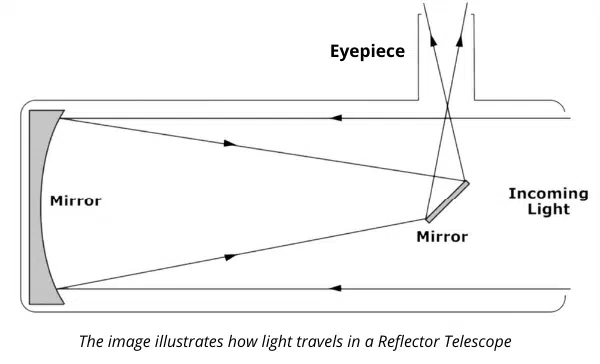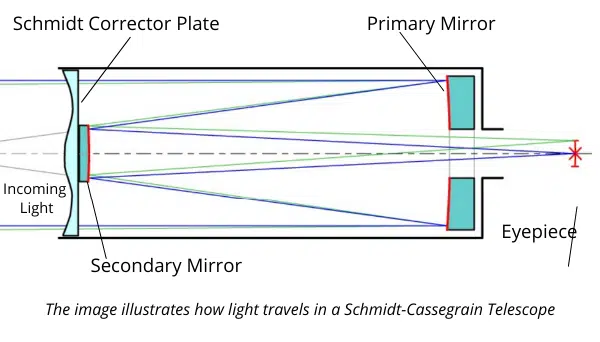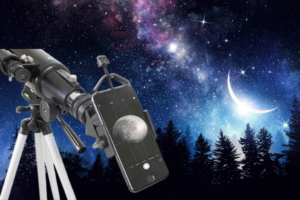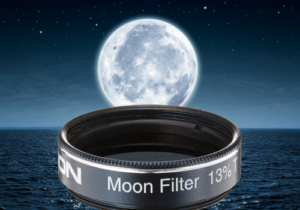Reflector vs Schmidt-Cassegrain Telescope: 5-Minute Read
Disclosure: This post contains affiliate links and I may earn a small commission (at no extra cost to you) if you click through and make a purchase. Thanks in advance – I really appreciate it!
When I was just starting out in the world of astronomy, I found it very difficult to pick out the best telescope for my needs. After doing some research on the telescope market, I realized it’s not really that difficult.
Whether a telescope is large or small, it is one of three types: refractor, reflector, or catadioptric telescope. The catadioptric category includes Schmidt-Cassegrain & Maksutov-Cassegrain telescope.
In this article, we will focus mainly on the differences between reflector and Schmidt-Cassegrain telescope.
Key Takeaways:
Reflector vs Schmidt Cassegrain
A reflector has two mirrors whereas a Schmidt-Cassegrain has two mirrors and a lens in the front. In a reflector telescope, the light rays are reflected to an eyepiece that’s at the side of the telescope, while in a Schmidt-Cassegrain, the eyepiece is located at the back of the telescope.
This was just the basic difference between the two telescope designs. Later in this article, I will compare Reflector vs Schmidt-Cassegrain on 7 key differentiating factors such as their optical performance, price, ease of use and maintenance, and more.
So if you’re someone who is serious about knowing the differences between the two so that you could decide which one is best for you, then read this article till the end.
Basic Features: Reflector vs Schmidt-Cassegrain
Before we compare each type of telescope on several factors, I think it would be great for you to quickly learn how Reflector and Schmidt-Cassegrain telescopes work.
What is a Reflector Telescope?
Reflecting telescopes are sometimes called Newtonian telescopes after their inventor Isaac Newton who built the first one in 1668.
They use mirrors to collect and focus the light towards the eyepiece. Mirrors are lighter than lenses and they are also easier to shape into a smooth and perfect surface.
A reflector telescope uses a concave primary mirror which is fixed at the back of the optical tube. The primary mirror reflects the light onto another flat secondary mirror which is precisely angled to deflect the image at a 90-degree angle to be viewed through an eyepiece.
The reflector telescopes are the most widespread telescopes in the market because of their easy building process and their low cost.
How Does a Reflector Telescope Work?

The OTA of a reflecting telescope has two mirrors: a concave primary mirror at the base, and a second flat mirror.
The primary mirror is located at the bottom of the scope while the secondary flat mirror is near the opening of the scope.
The primary mirror is angled to reflect light against the secondary mirror.
As light from the object enters the telescope, it travels down to the bottom and bounces off from the primary mirror.
After bouncing off, all light meets at the point where the secondary flat mirror is located. Then the flat mirror directs all reflected light rays towards the eyepiece.
Reflector telescopes are a great tool in observing celestial bodies near Earth but also excellent in viewing farther objects such as the moons of Saturn and Jupiter, distant galaxies, and nebulae.
Best Reflectors For Beginners
| Image | Title | Price | Buy |
|---|---|---|---|
 | Celestron - PowerSeeker 127EQ Telescope | See on Amazon | |
 | Celestron - AstroMaster 130EQ | See on Amazon | |
 | Orion 09007 SpaceProbe 130ST | See on Amazon | |
 | Orion 8945 SkyQuest XT8 Dobsonian | See on Amazon |
Product prices and availability are accurate as of the date/time indicated and are subject to change. Any price and availability information displayed on [relevant Amazon Site(s), as applicable] at the time of purchase will apply to the purchase of this product.
Prices pulled from the Amazon Product Advertising API on:What is a Schmidt-Cassegrain Telescope?
A Schmidt-Cassegrain Telescope or an SCT is a catadioptric telescope – a type of optical system that uses a combination of mirrors and lenses.
We know that a reflector uses two mirrors while a refractor telescope uses two lenses to refract the light entering to form an image.
A Schmidt-Cassegrain uses a combination of both mirrors and lenses, to be precise, it has 2 mirrors and an aspherical lens.
An SCT has the advantages of a reflector and a refractor, but most importantly it doesn’t have the flaws of either.
A refractor telescope suffers from chromatic aberration while a reflector faces issues with coma. An SCT on the other hand has none of these problems.
How Does a Schmidt-Cassegrain Telescope Work?
The Schmidt-Cassegrain is one of the most popular telescopes today, and it’s not hard to see why.
The SCT has an optical tube that is much more compact and portable than a reflector or refractor of the same aperture, and there is a huge selection of accessories available that are specifically designed for the Schmidt-Cassegrain.
Plus, with the addition of the proper diagonal, an SCT can be used for terrestrial viewing as well as astronomy, making the Schmidt-Cassegrain a flexible telescope that can be used for many applications.

Schmidt Cassegrain telescopes use mirrors and lenses to create a folded light path that provides a long focal length in a compact telescope tube. It involves a spherical, perforated primary mirror and convex secondary mirror with a very thin corrector lens.
The Schmidt-Cassegrain’s Schmidt correcting lens collects an object’s light. From that aspherical, or non-round, lens, the light goes to a round mirror at the back, which reflects it back toward the telescope’s front to another mirror and then light travels through a hole to the eyepiece, which is at the telescope’s back.
Schmidt-Cassegrains are shorter and wider than refractors and reflectors.
This is because their mirrors’ arrangement bounces, or folds, collected light back and forth within their compact spaces.
The gathered light’s focal length travels the same distance it would in refractors and reflectors, but it is folded within the short tubes of Schmidt-Cassegrains.
This is also the reason why an SCTs tube width may be one-half to one-third of the tube lengths.
Best Schmidt Cassegrain Telescopes
| Image | Title | Price | Buy |
|---|---|---|---|
 | Celestron - NexStar 8SE Telescope | See on Amazon | |
 | Celestron - NexStar 6SE Telescope | See on Amazon | |
 | Celestron CPC 1100 StarBright XLT | See on Amazon | |
 | Celestron NexStar Evolution Telescope, 9.25" | See on Amazon |
Product prices and availability are accurate as of the date/time indicated and are subject to change. Any price and availability information displayed on [relevant Amazon Site(s), as applicable] at the time of purchase will apply to the purchase of this product.
Prices pulled from the Amazon Product Advertising API on:Choosing Between a Reflector vs Schmidt-Cassegrain: 7 Key Differences
Now that you know the difference between the workings of a reflector as well as an SCT, it’s time to compare them both on some important factors.
1. Optical performance (Winner: High-quality reflectors & SCTs are equally good)
Both telescope designs provide solid imagery from faint deep space objects and both are color accurate too. In essence, Schmidt-Cassegrain and reflectors do have similar quality visuals but, SCT’s are a little more versatile for the more intermediate level astronomers who want to do more than just look through an eyepiece and observe stars and planets.
2. Price (Winner: Reflectors)
The reflector telescope has a much simpler design as compared to an SCT which also makes them much cheaper.
A reflector telescope uses only mirrors whereas an SCT uses mirrors as well as a lens. Lenses are generally more expensive to manufacture as compared to mirrors.
You may get a decent reflector for as little as $200 but you won’t see many SCTs under the $500 mark. Though you can find many under $1000, including the highly-regarded Celestron Nexstar SE series.
3. Maintenance & ease of use (Winner: Schmidt-Cassegrains)
SCTs are closed tubes and therefore do not get dust, and other elements. It is quite easy to maintain these telescopes.
Schmidt-Cassegrain telescopes are incredibly simple to use and maintain due to their design simplicity.
An SCT offers apparent advantages if you value comfort and convenience and want to be able to whip out your telescope at any moment and use it in minutes.
The reflectors, on the other hand, have an open tube design which makes them prone to all the environmental elements such as dust, insects, wind, and dew.
Although both reflectors and SCTs need to be collimated, reflectors will need to be collimated more due to the open tube design.
4. Size (Winner: Schmidt-Cassegrains)
Schmidt Cassegrain Telescopes utilize folded optics to allow for long focal lengths in a compact telescope design. This makes them one of the most compact telescopes per aperture — much shorter than refractors or reflectors of a similar aperture.
An SCT makes for a very compact design that delivers longer focal lengths and permits higher magnification. For example, a typical 8 inch SCT has a tube about 45cm long, which is a third of the length of an 8-inch Dobsonian.
The tube width of a Schmidt-Cassegrain telescope is typically one-half to one-third of the tube length.
5. For Deep-Sky Objects (Winner: Schmidt-Cassegrains)
Although reflectors are quite good for observing deep-space objects, SCT’s seem to be better.
The SCTs have long focal lengths, and a narrow field of view which makes them better for observing DSOs.
6. Astrophotography (Winner: Schmidt-Cassegrains)
SCT’s are far more versatile in the sense they can be great for astrophotography and tend to work far better with GoTo mounts over reflectors.
This is especially true for both planetary and deep-sky astrophotography. For planetary, SCTs are the preferred choice of some of the world’s best planetary imagers.
This is largely in part to their affordability for a long focal length telescope with a small central obstruction.
They also pair very well with Barlow lenses, which give the extra magnification required for planetary viewing and imaging.
This allows you to get approximately an f/20 telescope with just a 2x Barlow, leading to great quality images of the planets, moon, and the sun (when paired with a proper solar filter).
It’s also important to note that most entry-level SCTs come with an alt-az mount, which doesn’t lend well for deep sky imaging.
If you’re hoping to do deep sky imaging with an SCT, consider buying one that comes with an equatorial mount or buy the SCT telescope and equatorial mount separately.
7. Traveling & portability (Winner: Schmidt-Cassegrains)
If you’re looking for a grab-and-go lightweight telescope that you can carry along with you on your travels, then look no further than the small Schmidt-Cassegrain telescopes.
SCTs have become some of the most popular instruments for amateur astronomers and professional observatories alike, due to their ability to be compact, portable, and easy to use.
Since SCT’s focal length is much longer than the actual physical length of the tube, they are very portable and lightweight options for travel.
Reflector Telescope Pros & Cons
Pros
- Great for beginners as well as professionals
- Large aperture
- Affordable
- Stable solid mount
- Great for deep-sky objects
- Provides the best performance to price ratio
Cons
- Cheaper models may come with shaky tripods
- Need polar alignment
- Require frequent collimation
- Beginners may need some practice
Schmidt-Cassegrain Telescope Pros & Cons
Pros
- Short tube length
- Good for viewing planets
- Easy to use
- Lightweight
- Portable
- Visual back SC threading allows a variety of accessories to be used
- Can be fast and easy to setup
- Good for visual
- Good for astrophotography
- Very little chromatic aberration
Cons
- Tend to be “slow” telescopes
- Large secondary mirrors
- Requires collimation
- More moving parts in the OTA
- More expensive
- Require occasional minor alignment
- Narrow field of view
Conclusion
Besides the corrector plate used, a Schmidt-Cassegrain telescope is essentially a spherical mirror-based reflector so the color quality and accuracy shouldn’t be too far from a reflector. Nevertheless, the two optical variations do have their differences, which is clearly illustrated by their designs and of course from the points mentioned above.
If you’re a beginner and want the best bang for your buck, then a reflector telescope is the way to go. On the other hand, if you’re an intermediate user or a professional with a bigger budget, then an SCT would be a better option for you.
Schmidt-Cassegrain telescopes are wonderful for all-around observing of the Moon, planets, double stars, and narrow-field views of deep-sky objects.
In short, observers with a larger budget who still want aperture but who favor portability will find the Cassegrain suitable for their needs.
Written by:

Kavya Joshi
My love affair with space began in a field in India at the age of 7, when I looked up at the Milky Way for the first time. Ever since, I have been attempting to cram in every fact about the Universe, I can find into my head.
ABOUT US
We are a team of active amateur astronomers, here to help you with all your astronomy and science related needs – this is anything, from reviewing the latest telescopes to be released to talking about gravity and neurons. The Big Bang Optics was started because of our love for astronomy and to help others like us find the best telescope and accessories.
LEGAL DISCLAIMER
The Big Bang Optics is a participant in the Amazon Services LLC Associates Program, an affiliate advertising program designed to provide a means for sites to earn advertising fees by advertising and linking to Amazon.com. The Big Bang Optics also participates in affiliate programs with Clickbank and other sites. The Big Bang Optics is compensated for referring traffic and business to these companies.




